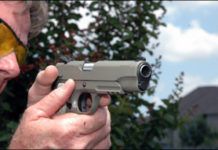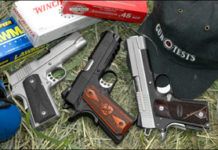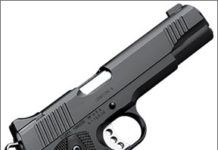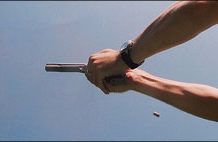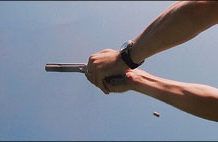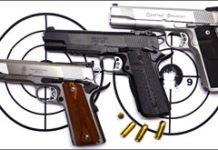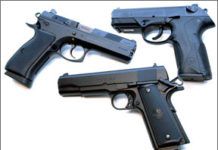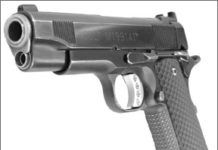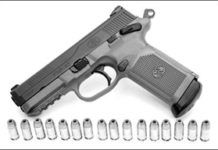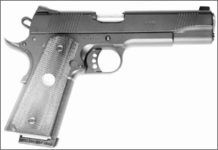Full-Size 1911s with Accessory Rails: Kimber vs. Double Star
When it comes to producing a Gun Tests evaluation, the process can be complicated by differences in operation. For example, a tight protocol, such as 9mm polymer pistols with 4-inch barrels and identical capacity, can challenge our test staff to master a different trigger for each gun. That won't be the case here, because the operational differences in these two guns are subtle, despite their vastly different cosmetics.
Our 45 ACP test guns were the Kimber Desert Warrior, $1441, and the Double Star DSC Combat Pistol, $1350. Despite having so much in common with the Kimber, the appearance of the DSC Combat Pistol could not have been further from that of the Desert Warrior. If you love the way your AR-15 "black gun" looks, the Double Star Combat Pistol provides a matching sidearm. Only the stainless-steel barrel hood and aluminum trigger broke up the understated color scheme. In contrast, the choice of color and the unusual grips found on the Desert Warrior set the gun apart from other 1911s. Officially, the color of the frame and slide were Desert Tan, but it could also be called khaki. The appearance of a lanyard loop at the bottom of the mainspring housing was also a distinctive touch.
To get started with the test, we first made sure each gun was lubricated. These are steel guns with a lot of metal-to-metal contact. We lubricated the slide and frame rails, the disconnector, the swinging link, each side of the hammer and along the outer surface of the barrel. The barrel lugs were lubricated by filling the matching wells beneath the slide with BreakFree CLP oil.
We began our tests by cleaning out the ammo closet, shooting each gun with a variety of rounds, including 200-grain lead semiwadcutters from Black Hills Ammunition. We then settled in at [IMGCAP(2)]our bench along the 25-yard line. Here we fired 10 round groups from a sandbag rest. Our test ammunition was Wolf 230-grain Copper FMJ with steel cases and non-corrosive primers, 200-grain JHP/XTP +P Hornady rounds, and Federal 230-grain Hydra-Shok JHP ammunition.
Our big question: Since the guns were essentially the same mechanically, would the statistical results be a dead heat? Or would our guns exhibit distinctly different personalities? Let's find out.
Short 45 ACPs from Sig Sauer, Kimber, and Springfield Armory
Short 45 ACPs from Sig Sauer, Kimber, and Springfield Armory
Wild Bunch Pistols, Part II: Kimber Wins Modern Guns Test
In our May 2010 review of pistols suited for Cowboy Action's widely popular new Wild Bunch side match, we noted two different categories of 1911s eligible to compete. There are two SASS classes set forth for 1911 handguns, which roughly correlate to the traditional and modern single-action class.
In our first review of handguns suited for the SASS Wild Bunch category—named in deference to the Sam Peckinpah movie, The Wild Bunch—we covered five traditional GI-type handguns from Springfield Armory, High Standard, and Colt. Prices ranged from $500 to $1000, a fairly large spread. The Springfield pistols included the GI Model, a stainless GI, and the Mil-Spec. The High Standard pistol was the 1911A1, and the Colt, the 1918 Black Army.
Recapping those guns, we said the Springfield Armory GI PW9108LP 45 ACP, $643, was the archetypical Wild Bunch pistol, meeting the rule specifications to a "T". The pistol features fixed sights, standard controls, and checkered plastic grips. We gave it a B+. Next, the Springfield Armory Stainless GI PW9151LP 45 ACP, $693, was identical in features to the Parkerized GI pistol reviewed above. For a modest additional cost, the stainless GI pistol offers an excellent appearance. Our testers said it was easily the best-looking handgun in the matchup. Still, it scored a C grade based on its poor accuracy and initial malfunctions. The third Springfield was the company's Mil-Spec PB9108LP Parkerized 45 ACP, $753, which earned an A grade and a Best Buy recommendation for its superb accuracy and flawless function.
The two non-Springfield guns were the High Standard 1911A1 HSTX1911 45 ACP, $480, a ‘B'-rated gun, which we said was not the best-finished pistol, but it worked and gave adequate accuracy. Last was a Colt Black Army 1918 No. 01018 45 ACP, $1000, the most expensive pistol tested, which also earned an A grade and was our team's favorite.
The "modern" class of 45s we test this month nods to the notion that quite a few SASS members probably already own such a handgun, and interested shooters from other disciplines may jump in to shoot Wild Bunch matches. The handguns legal for use in this category are middle-of-the-road pistols. High-visibility sights without night inserts are allowed and so are forward cocking serrations and full-length guide rods. Checkered grip straps are not allowed. Your Springfield TRP and Kimber Gold Match are not legal. We eliminated a number of capable 1911 handguns in the same price range because of the frame checkering and stippling limit. Getting something for free is an advantage, but in this case the advantages were "illegal" for competition.
Our Kimber entry was the Custom II 45 ACP, $828, which has been available for more than a decade and remains an excellent buy among 1911 handguns. Set against it was the Para Ordnance PXT 7.45 45 ACP, $986, and another Springfield, the Loaded Model PX9109LP 45 ACP, $1035.
Since SASS rules demand lead bullets running at less than 1000 fps, our test program for these guns was different. Personal defense was not a consideration, and neither was jacketed hollowpoint bullet performance. The choices among factory ammunition are limited. From Black Hills, we chose a 230-grain roundnose lead load and a 200-grain semiwadcutter. Then we worked up a handload using the Oregon Trail 200-grain semiwadcutter over 5.5 grains of WW 231, a proven accuracy load. It was essential each handgun perform well with these typical match loads.
In the previous test, all of the GI pistols and the modern Loaded Model in this test were Series 70 types, with no firing pin block, although the Springfield pistols offer a lightweight firing pin and extra power spring. Among the modern guns this round, the Para Ordnance is a Series 80-type pistol with a positive firing pin block, and the Kimber Custom II uses the Schwarz-type firing pin block.
We don't think that obtaining an original-period Colt 1911 is the best route to compete in SASS's Wild Bunch matches. They are expensive, with the cheaper samples beginning at $1000. The older pistols were of softer steel than we use today, and commonsense tells us a shooter pistol from the era is probably well worn.
Here's what we learned about the second round of Wild Bunch guns:
Wild Bunch Pistols: Colt 1918 Leads The Pack, But At A Price!
Wild Bunch Pistols: Colt 1918 Leads The Pack, But At A Price!
Fine Factory 1911s: S&W, STI, Springfield Armory Battle
Affordable 45s: Para USA, CZ, and Beretta Shoot It Out
When it comes to 45 ACP semi-automatics, we're always looking for ways to fill our holsters without emptying our bank accounts. There are many 45s that cost about $1200, and it's not hard to find 45s that cost twice that or more. In this test we will look at three affordable 45s with suggested retail prices that are well under the $1000 mark. Aside from categorizing by price, both the $650 Beretta PX4 Storm F and the $874 CZ 97BD could also be categorized as traditional double action (TDA) guns. We compared these guns to a $600 single-action 1911, the new Para USA GI Expert.
We followed the same test procedure as our last evaluation of 45 ACP pistols published in the April 2009 issue. We fired five-shot groups from a bench at targets 15 yards downrange. Then, we put our guns through an action test of firing 10 three-shot strings standing offhand at an IPSC Metric target 7 yards away. Using a shot-activated electronic timer, we began with the pistol held chest high with both hands. Upon an audible start signal, we pushed the gun toward the target and attempted to land two hits inside the 5.9-inch-wide by 11.1-inch-high A-zone located at center mass, followed by a single shot to the B-zone, which delineated the head area of our target. This area was 6.4 inches by 6.9 inches. We've used this procedure many times before and think it offers valuable insight into what is required to bring the gun into action. We shot this test at the Impact Zone in Monaville, Texas (theimpactzonerange.com).
What proved more difficult than formulating a test procedure was finding ammunition. Supplies of popular calibers such as 45 ACP have all but dried up. If we hadn't visited Top Gun in Houston (topgunrange.com), we may not have been able to find any reasonably priced ammunition at all. To test we purchased a supply of Hornady 200-grain XTP hollowpoints for about $22 per 20-round box. We handloaded two other test rounds. They consisted of cases topped with Zero brand 185-grain jacketed hollowpoints and 200-grain roundnosed lead bullets by Bushwacker. Each round was powered by Winchester 231 powder with charges about midway between the starting load and the maximum load, as per Hodgdon's latest load data. We used Winchester large pistol primers, and the rounds were loaded on a Dillon Precision Super 1050. Both our handloads were previously developed for competition, so we knew our rounds would be safe and accurate. Throughout our tests, all three guns performed without malfunction, so we were able to concentrate on the handling and performance of each pistol. Here is what we found in our side-by-side evaluations:
High-End 45 ACP Follow-Up: Michiguns Commander Custom
High-End 45 ACP Follow-Up: Michiguns Commander Custom
Double-Column 45 ACPs: CZ, H&K, and FN Shoot It Out
Terrific Trio of Custom 45s: Volkmann, Wilson, Les Baer
If you have over two grand to put into a good 45 auto, which one will you get? For that kind of money you can pretty much tell a custom builder what you want and expect to get it, can't you? Not quite, as it turns out. Or can you be satisfied with a fairly standard, if costly, over-the-counter 1911? We decided to take a look at some of the higher-priced 45s to see what gives. The test guns were full-size 1911s in 45 ACP caliber. We obtained a pistol called the Combat Custom ($2895 as tested) from a relatively new maker, Luke Volkmann of Volkmann Custom Inc., who will give you pretty much what you want for options, which we pitted against Wilson's CQB ($2550) and Les Baer's Premier II Super-Tac ($2280).
Attempting to pick the best one out of all these very fine handguns was anything but easy. They are all excellent, with fine triggers, great accuracy, and many touches that set them apart from the ordinary. In light of the ongoing national surge to buy all kinds of firearms, especially those designed for self defense, you may have a hard time finding one of these better-grade 1911s.
We shot the guns for accuracy and function, and evaluated them for self-defense training and general use. These were all outstanding pistols, yet we found some anomalies that might help you pick and choose. We tested with four types of ammunition, Black Hills' hardball, Federal 185-grain Hi-Shok JHP, Cor-Bon 230-grain JHP, and with cast-lead, 230-grain round-nose Ultramax. We tested during a severe winter in Idaho, and thus had trouble achieving these guns' full accuracy potential. Better conditions would have given better results, but the conditions were the same for all guns and thus valid for reference. They are hardly what you'd call lousy. Also, we shot two other known handguns every now and then during these tests to make sure we were not too far off base. Here is what we found.
































